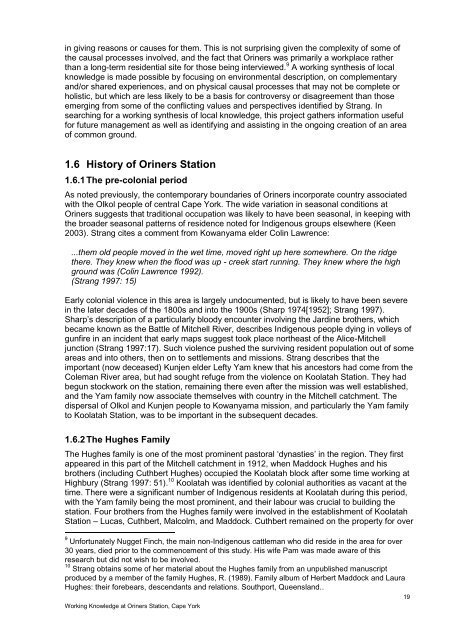WfHC - cover page (not to be used with pre-printed report ... - CSIRO
WfHC - cover page (not to be used with pre-printed report ... - CSIRO
WfHC - cover page (not to be used with pre-printed report ... - CSIRO
You also want an ePaper? Increase the reach of your titles
YUMPU automatically turns print PDFs into web optimized ePapers that Google loves.
in giving reasons or causes for them. This is <strong>not</strong> surprising given the complexity of some of<br />
the causal processes involved, and the fact that Oriners was primarily a workplace rather<br />
than a long-term residential site for those <strong>be</strong>ing interviewed. 9 A working synthesis of local<br />
knowledge is made possible by focusing on environmental description, on complementary<br />
and/or shared experiences, and on physical causal processes that may <strong>not</strong> <strong>be</strong> complete or<br />
holistic, but which are less likely <strong>to</strong> <strong>be</strong> a basis for controversy or disagreement than those<br />
emerging from some of the conflicting values and perspectives identified by Strang. In<br />
searching for a working synthesis of local knowledge, this project gathers information useful<br />
for future management as well as identifying and assisting in the ongoing creation of an area<br />
of common ground.<br />
1.6 His<strong>to</strong>ry of Oriners Station<br />
1.6.1 The <strong>pre</strong>-colonial period<br />
As <strong>not</strong>ed <strong>pre</strong>viously, the contemporary boundaries of Oriners incorporate country associated<br />
<strong>with</strong> the Olkol people of central Cape York. The wide variation in seasonal conditions at<br />
Oriners suggests that traditional occupation was likely <strong>to</strong> have <strong>be</strong>en seasonal, in keeping <strong>with</strong><br />
the broader seasonal patterns of residence <strong>not</strong>ed for Indigenous groups elsewhere (Keen<br />
2003). Strang cites a comment from Kowanyama elder Colin Lawrence:<br />
...them old people moved in the wet time, moved right up here somewhere. On the ridge<br />
there. They knew when the flood was up - creek start running. They knew where the high<br />
ground was (Colin Lawrence 1992).<br />
(Strang 1997: 15)<br />
Early colonial violence in this area is largely undocumented, but is likely <strong>to</strong> have <strong>be</strong>en severe<br />
in the later decades of the 1800s and in<strong>to</strong> the 1900s (Sharp 1974[1952]; Strang 1997).<br />
Sharp‟s description of a particularly bloody encounter involving the Jardine brothers, which<br />
<strong>be</strong>came known as the Battle of Mitchell River, descri<strong>be</strong>s Indigenous people dying in volleys of<br />
gunfire in an incident that early maps suggest <strong>to</strong>ok place northeast of the Alice-Mitchell<br />
junction (Strang 1997:17). Such violence pushed the surviving resident population out of some<br />
areas and in<strong>to</strong> others, then on <strong>to</strong> settlements and missions. Strang descri<strong>be</strong>s that the<br />
important (now deceased) Kunjen elder Lefty Yam knew that his ances<strong>to</strong>rs had come from the<br />
Coleman River area, but had sought refuge from the violence on Koolatah Station. They had<br />
<strong>be</strong>gun s<strong>to</strong>ckwork on the station, remaining there even after the mission was well established,<br />
and the Yam family now associate themselves <strong>with</strong> country in the Mitchell catchment. The<br />
dispersal of Olkol and Kunjen people <strong>to</strong> Kowanyama mission, and particularly the Yam family<br />
<strong>to</strong> Koolatah Station, was <strong>to</strong> <strong>be</strong> important in the subsequent decades.<br />
1.6.2 The Hughes Family<br />
The Hughes family is one of the most prominent pas<strong>to</strong>ral „dynasties‟ in the region. They first<br />
appeared in this part of the Mitchell catchment in 1912, when Maddock Hughes and his<br />
brothers (including Cuth<strong>be</strong>rt Hughes) occupied the Koolatah block after some time working at<br />
Highbury (Strang 1997: 51). 10 Koolatah was identified by colonial authorities as vacant at the<br />
time. There were a significant num<strong>be</strong>r of Indigenous residents at Koolatah during this period,<br />
<strong>with</strong> the Yam family <strong>be</strong>ing the most prominent, and their labour was crucial <strong>to</strong> building the<br />
station. Four brothers from the Hughes family were involved in the establishment of Koolatah<br />
Station – Lucas, Cuth<strong>be</strong>rt, Malcolm, and Maddock. Cuth<strong>be</strong>rt remained on the property for over<br />
9 Unfortunately Nugget Finch, the main non-Indigenous cattleman who did reside in the area for over<br />
30 years, died prior <strong>to</strong> the commencement of this study. His wife Pam was made aware of this<br />
research but did <strong>not</strong> wish <strong>to</strong> <strong>be</strong> involved.<br />
10 Strang obtains some of her material about the Hughes family from an unpublished manuscript<br />
produced by a mem<strong>be</strong>r of the family Hughes, R. (1989). Family album of Her<strong>be</strong>rt Maddock and Laura<br />
Hughes: their fore<strong>be</strong>ars, descendants and relations. Southport, Queensland..<br />
Working Knowledge at Oriners Station, Cape York<br />
19
















